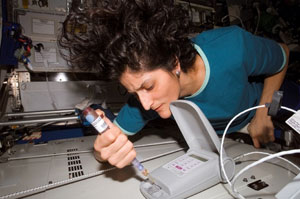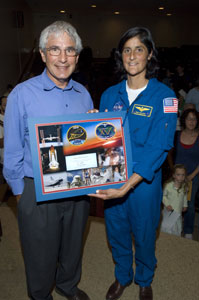 |
 |
|
 |
 |
 |
 |
 |
|
 |
 |
 |
 |
 |
|
Astronaut Suni Williams, Expedition 14 flight engineer, works with the Lab-on-a-Chip Application Development-Portable Test System (LOCAD-PTS) experiment in the Destiny laboratory of the International Space Station. Williams trained at the MBL to use the system, which detects biological and chemical substances. Photo courtesy of NASA.
|
|
Science in Orbit
Astronaut Suni Williams leverages her MBL training in space
NASA astronaut and flight engineer Suni Williams came back to the MBL on September 12 to give an uplifting talk on her recent six-month stay at the International Space Station. Williams showed light-hearted videos of her life in microgravity – from eating food out of mid-air to spacewalking to running the Boston Marathon on a treadmill (a “first” in space). Orbiting 210 miles above the Earth, Williams ran scientific tests at the ISS, for which she prepared by spending three weeks at the MBL in 2004 along with three other astronauts as part of a training workshop aimed at providing science background and laboratory training for astronauts. Suni returned to Earth in June 2007, having set the world record for female spacewalks with four, totaling nearly 30 hours.
Among those on hand to introduce Williams at Lillie Auditorium were Mitchell Sogin, director of the Josephine Bay Paul Center, who gave a refresher on the MBL/WHOI Astrobiology Team and its research; and Tim Shank of Woods Hole Oceanographic Institution. Last January, Williams and Shank shared an historically long-distance phone conversation, she talking from the ISS and he from the Alvin submersible 1-1/2 miles below the ocean’s surface.
Here Williams recalls what she gained from her MBL experience.
Q. What was the intent of the MBL program for astronauts?
A. Some of us going up there [into space] don’t have a science background, so it was to introduce us to some investigators as well as to some scientific techniques. We were working out of Norm Wainwright’s lab doing all these different types of experiments. One of them was Norm’s experiment [the Lab-on-a-Chip Application Development Portable Test system – a handheld device for rapid detection of bacteria on space station surfaces]. We got an idea of its background and its application for space. And then it flew on the Shuttle Flight that took me up and I was the first one to use it in space. It’s essentially a swabbing technique with a spectrometer. We had other, known ways to detect bacteria, so we were able to compare, up in space, if this instrument was working correctly. [It was. The instrument uses Limulus amebocyte lysate (LAL) from horseshoe crab blood to detect bacterial endotoxin. LAL was first isolated at the MBL in the 1960s by Frederick Bang and Jack Levin. Wainwright, a former MBL Senior Scientist, is presently with Charles River Laboratories in Charleston, S.C.]
Q. How did the MBL program come about?
A. Dan Barry [former NASA astronaut and former MBL Grass Fellow] set up the program for us at the MBL. I think it’s a great idea. We need someone to emphasize this program again. It really helped me in understanding some of the science I was doing up there, and having an appreciation for it. I’m not a scientist by trade, and so when I had to do the science, I knew the right questions to ask. I knew what they were potentially thinking about and the scientific methods that were involved in the analysis.
Q. What other experiments did you do at the MBL?
A. We did some work with the fruit fly, Drosophila. This is currently an experiment out of NASA’s Ames Research Center on how you can test for genetic changes in space. I didn’t do that but it’s been on the shuttle. [Roger Hanlon] at the MBL talked to us about cuttlefish and camouflage, and we also worked with the microscope folks there. As a matter of fact, we will be putting a space microscope in the ISS in next few years. This is a project out of Glenn Research Center. They had to go through the whole idea of how do you put a sample on the microscope in a closed environment and be able to look at it? It poses all sorts of difficulties when you are in space. This way, maybe we can analyze some of the samples we are taking up there rather than having to send them home.
 |
|
| Mitch Sogin, Director of the Bay Paul Center and Principal Investigator of the MBL's NASA Astrobiology Institute research team accepts a plaque on behalf of the MBL from NASA Astronaut Suni Williams, who shared her experience of living and working in space in a talk at the MBL held September 12. In 2004, Williams was one of four NASA astronauts who participated in an workshop at the MBL aimed at providing science background and laboratory training to astronauts for future missions on the International Space Station, the Moon, and eventually Mars. |
|
Q. You may consider yourself a scientist in training, but you certainly seem to be a good engineer. You were always installing or fixing or replacing equipment at the ISS, even during spacewalks.
A. Thank you! It’s fun. My husband would argue with you and say, ‘Why can’t you change the oil in the car?’
Q. Well, maybe you’d do want to try that in microgravity, where it would be more of a challenge! Thank you for coming to Woods Hole.
A. Hopefully I stirred up the pot a little bit and make people think about how jointly we are (working together). It’s so interesting, how similar but how different our three programs at NASA, WHOI and the MBL are.
|
| |

 |
|
 |
 |
|